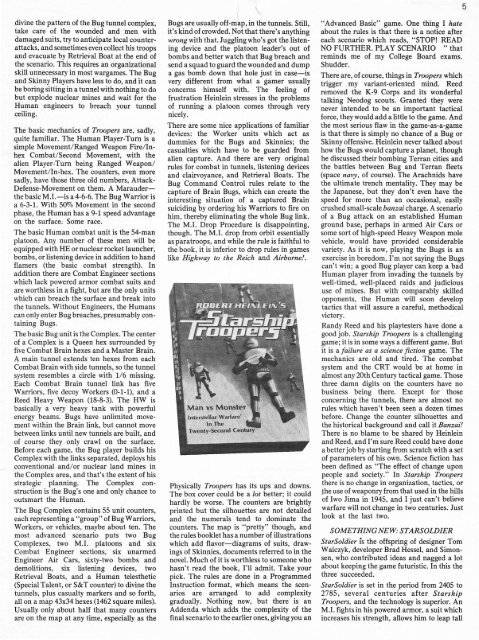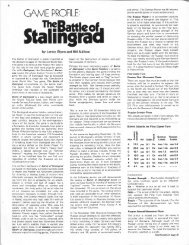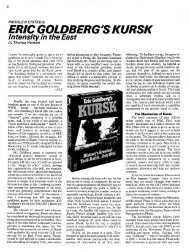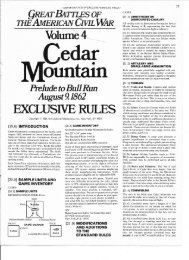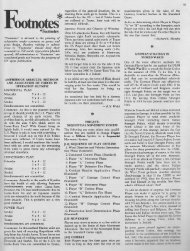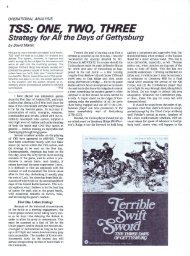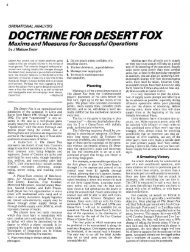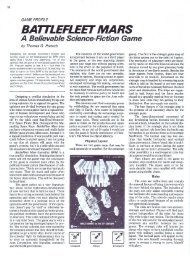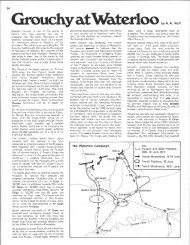StarSoldier - Learning SPI's Great Battles of the American Civil War
StarSoldier - Learning SPI's Great Battles of the American Civil War
StarSoldier - Learning SPI's Great Battles of the American Civil War
Create successful ePaper yourself
Turn your PDF publications into a flip-book with our unique Google optimized e-Paper software.
divine <strong>the</strong> pattern <strong>of</strong> <strong>the</strong> Bug tunnel complex,<br />
take care <strong>of</strong> <strong>the</strong> wounded and men with<br />
damaged suits, try to anticipate local counterattacks,<br />
and sometimes even collect his troops<br />
and evacuate by Retrieval Boat at <strong>the</strong> end <strong>of</strong><br />
<strong>the</strong> scenario. This requires an organizational<br />
skill unnecessary in most wargames. The Bug<br />
and Skinny Players have less to do, and it can<br />
be boring sitting in a tunnel with nothing to do<br />
but explode nuclear mines and wait for <strong>the</strong><br />
Human engineers to breach your tunnel<br />
ceiling.<br />
The basic mechanics <strong>of</strong> Troopers are, sadly,<br />
quite familiar. The Human Player-Turn is a<br />
simple Movement/Ranged Weapon Fire/Inhex<br />
Combat/Second Movement, with <strong>the</strong><br />
alien Player-Turn being Ranged Weapon/<br />
Movement/In-hex. The counters, even more<br />
sadly, have those three old numbers, Attack-<br />
Defense-Movement on <strong>the</strong>m. A Marauder<strong>the</strong><br />
basic M.I.-is a 4-6-6. The Bug <strong>War</strong>rior is<br />
a 6-3-1. With 50% Movement in <strong>the</strong> second<br />
phase, <strong>the</strong> Human has a 9-1 speed advantage<br />
on <strong>the</strong> surface. Some race.<br />
The basic Human combat unit is <strong>the</strong> 54-man<br />
platoon. Any number <strong>of</strong> <strong>the</strong>se men will be<br />
equipped with HE or nuclear rocket launcher,<br />
bombs, or listening device in addition to hand<br />
flamers (<strong>the</strong> basic combat strength). In<br />
addition <strong>the</strong>re are Combat Engineer sections<br />
which lack powered armor combat suits and<br />
are worthless in a fight, but are <strong>the</strong> only units<br />
which can breach <strong>the</strong> surface and break into<br />
<strong>the</strong> tunnels. Without Engineers, <strong>the</strong> Humans<br />
can only enter Bug breaches, presumably containing<br />
Bugs.<br />
The basic Bug unit is <strong>the</strong> Complex. The center<br />
<strong>of</strong> a Complex is a Queen hex surrounded by<br />
five Combat Brain hexes and a Master Brain.<br />
A main tunnel extends ten hexes from each<br />
Combat Brain with side tunnels, so <strong>the</strong> tunnel<br />
system resembles a circle with 1/6 missing.<br />
Each Combat Brain tunnel link has five<br />
<strong>War</strong>riors, five decoy Workers (0-1-1), and a<br />
Reed Heavy Weapon (18-8-3). The HW is<br />
basically a very heavy tank with powerful<br />
energy beams. Bugs have unlimited movement<br />
within <strong>the</strong> Brain link, but cannot move<br />
between links until new tunnels are built, and<br />
<strong>of</strong> course <strong>the</strong>y only crawl on <strong>the</strong> surface.<br />
Before each game, <strong>the</strong> Bug player builds his<br />
Complex with <strong>the</strong> links separated, deploys his<br />
conventional and/or nuclear land mines in<br />
<strong>the</strong> Complex area, and that's <strong>the</strong> extent <strong>of</strong> his<br />
strategic planning. The Complex construction<br />
is <strong>the</strong> Bug's one and only chance to<br />
outsmart <strong>the</strong> Human.<br />
The Bug Complex contains 55 unit counters,<br />
each representing a "group" <strong>of</strong> Bug <strong>War</strong>riors,<br />
Workers, or vehicles, maybe about ten. The<br />
most advanced scenario puts two Bug<br />
Complexes, two M.l. platoons and six<br />
Combat Engineer sections, six unarmed<br />
Engineer Air Cars, sixty-two bombs and<br />
demolitions, six listening devices, two<br />
Retrieval Boats, and a Human teles<strong>the</strong>tic<br />
(Special Talent, or S&T counter) to divine <strong>the</strong><br />
tunnels, plus casualty markers and so forth,<br />
all on a map 43x34 hexes (1462 square miles).<br />
Usually only about half that many counters<br />
are on <strong>the</strong> map at any time, especially as <strong>the</strong><br />
I<br />
Bugs are usually <strong>of</strong>f-map, in <strong>the</strong> tunnels. Still,<br />
it's kind <strong>of</strong> crowded. Not that <strong>the</strong>re's anything<br />
wrong with that. Juggling who's got <strong>the</strong> listening<br />
device and <strong>the</strong> platoon leader's out <strong>of</strong><br />
bombs and better watch that Bug breach and<br />
send a squad to guard <strong>the</strong> wounded and dump<br />
a gas bomb down that hole just in case-is<br />
very different from what a gamer usually<br />
concerns himself with. The feeling <strong>of</strong><br />
frustration Heinlein stresses in <strong>the</strong> problems<br />
<strong>of</strong> running a platoon comes through very<br />
nicely.<br />
There are some nice applications <strong>of</strong> familiar<br />
devices: <strong>the</strong> Worker units which act as<br />
dummies for <strong>the</strong> Bugs and Skinnies; <strong>the</strong><br />
casualties which have to be guarded from<br />
alien capture. And <strong>the</strong>re are very original<br />
rules for combat in tunnels, listening devices<br />
and clairvoyance, and Retrieval Boats. The<br />
Bug Command Control rules relate to <strong>the</strong><br />
capture <strong>of</strong> Brain Bugs, which can create <strong>the</strong><br />
interesting situation <strong>of</strong> a captured Brain<br />
suiciding by ordering his <strong>War</strong>riors to fire on<br />
him, <strong>the</strong>reby eliminating <strong>the</strong> whole Bug link.<br />
The M.l. Drop Procedure is disappointing,<br />
though. The M.I. drop from orbit essentially<br />
as paratroops, and while <strong>the</strong> rule is faithful to<br />
<strong>the</strong> book, it is inferior to drop rules in games<br />
like Highway to <strong>the</strong> Reich and Airborne!.<br />
Physically Troopers has its ups and downs.<br />
The box cover could be a lot better; it could<br />
hardly be worse. The counters are brightly<br />
printed but <strong>the</strong> silhouettes are not detailed<br />
and <strong>the</strong> numerals tend to dominate <strong>the</strong><br />
counters. The map is "pretty" though, and<br />
<strong>the</strong> rules booklet has a number <strong>of</strong> illustrations<br />
which add flavor-diagrams <strong>of</strong> suits, drawings<br />
<strong>of</strong> Skinnies, documents referred to in <strong>the</strong><br />
novel. Much <strong>of</strong> it is worthless to someone who<br />
hasn't read <strong>the</strong> book, I'll admit. Take your<br />
pick. The rules are done in a Programmed<br />
Instruction format, which means <strong>the</strong> scenarios<br />
are arranged to add complexity<br />
gradually. Nothing new, but <strong>the</strong>re is an<br />
Addenda which adds <strong>the</strong> complexity <strong>of</strong> <strong>the</strong><br />
final scenario to <strong>the</strong> earlier ones, givingyou an<br />
\<br />
"Advanced Basic" game. One thing I hate<br />
about <strong>the</strong> rules is that <strong>the</strong>re is a notice after<br />
each scenario which reads, "STOP! READ<br />
NO FURTHER. PLAY SCENARIO "that<br />
reminds me <strong>of</strong> my College Board exams.<br />
Shudder.<br />
There are, <strong>of</strong> course, things in Troopers which<br />
trigger my variant-oriented mind. Reed<br />
removed <strong>the</strong> K-9 Corps and its wonderful<br />
talking Neodog scouts. Granted <strong>the</strong>y were<br />
never intended to be an important tactical<br />
force, <strong>the</strong>y would add a little to <strong>the</strong> game. And<br />
<strong>the</strong> most serious flaw in <strong>the</strong> game-as-a-game<br />
is that <strong>the</strong>re is simply no chance <strong>of</strong> a Bug or<br />
Skinny <strong>of</strong>fensive. Heinlein never talked about<br />
how <strong>the</strong> Bugs would capture a planet, though<br />
he discussed <strong>the</strong>ir bombing Terran cities and<br />
<strong>the</strong> battles between Bug and Terran fleets<br />
(space navy, <strong>of</strong> course). The Arachnids have<br />
<strong>the</strong> ultimate trench mentality. They may be<br />
<strong>the</strong> Japanese, but <strong>the</strong>y don't even have <strong>the</strong><br />
speed for more than an occasional, easily<br />
crushed small-scale banzai charge. A scenario<br />
<strong>of</strong> a Bug attack on an established Human<br />
ground base, perhaps in armed Air Cars or<br />
some sort <strong>of</strong> high-speed Heavy Weapon mole<br />
vehicle, would have provided considerable<br />
variety. As it is now, playing <strong>the</strong> Bugs is an<br />
exercise in boredom. I'm not saying <strong>the</strong> Bugs<br />
can't win; a good Bug player can keep a bad<br />
Human player from invading <strong>the</strong> tunnels by<br />
well-timed, well-placed raids and judicious<br />
use <strong>of</strong> mines. But with comparably skilled<br />
opponents, <strong>the</strong> Human will soon develop<br />
tactics that will assure a careful, methodical<br />
victory.<br />
Randy Reed and his playtesters have done a<br />
good job. Starship Troopers is a challenging<br />
game; it is in some ways a different game. But<br />
it is a failure as a science fiction game. The<br />
mechanics are old and tired. The combat<br />
system and <strong>the</strong> CRT would be at home in<br />
almost any 20th Century tactical game. Those<br />
three damn digits on <strong>the</strong> counters have no<br />
business being <strong>the</strong>re. Except for those<br />
concerning <strong>the</strong> tunnels, <strong>the</strong>re are almost no<br />
rules which haven't been seen a dozen times<br />
before. Change <strong>the</strong> counter silhouettes and<br />
<strong>the</strong> historical background and call it Banzai!<br />
There is no blame to be shared by Heinlein<br />
and Reed, and I'm sure Reed could have done<br />
a better job by starting from scratch with a set<br />
<strong>of</strong> parameters <strong>of</strong> his own. Science fiction has<br />
been defined as "The effect <strong>of</strong> change upon<br />
people and society." In Starship Troopers<br />
<strong>the</strong>re is no change in organization, tactics, or<br />
<strong>the</strong> use <strong>of</strong> weaponry from that used in <strong>the</strong> hills<br />
<strong>of</strong> Iwo Jima in 1945, and I just can't believe<br />
warfare will not change in two centuries. Just<br />
look at <strong>the</strong> last two.<br />
SOMETHING NEW: STARSOLDIER<br />
<strong>StarSoldier</strong> is <strong>the</strong> <strong>of</strong>fspring <strong>of</strong> designer Tom<br />
Walczyk, developer Brad Hessel, and Simonsen,<br />
who contributed ideas and nagged a lot<br />
about keeping <strong>the</strong> game futuristic. In this <strong>the</strong><br />
three succeeded.<br />
<strong>StarSoldier</strong> is set in <strong>the</strong> period from 2405 to<br />
2785, several centuries after St arship<br />
Troopers, and <strong>the</strong> technology is superior. An<br />
M.l. fights in his powered armor, a suit which<br />
increases his strength, allows him to leap tall<br />
5


